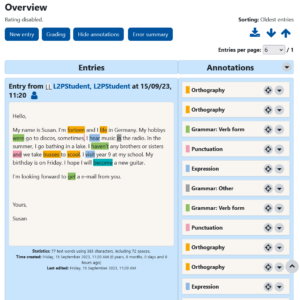
Source: Own illustration
Since 2019, RWTHmoodle has been part of everyday teaching and learning and is constantly being further developed to make E-Learning easier for students and teachers.
This winter semester, there are four new features as well as two plugins that can be tested in pilot operation by interested teachers.
In September, all professors and academic staff received an e-mail to find test subjects for the new plugins. At the end of the pilot phase, an evaluation will be conducted to decide whether the plugins will be used permanently.
You can find out which pilot plugins and innovations these are in the
following blog post.
The Pilot Plugins
1. Margic
This plugin allows students to create texts that can subsequently be annotated and graded by their instructors. The texts are only visible to the respective authors and lecturers. Unlike PDF Annotation, the plugin is not suitable for collaborative work.
2. “Word Cloud”
Surely most of you are familiar with word cloud. The purpose of the plugin is to collect terms on a certain topic. These are displayed accordingly depending on their frequency. The “Word Cloud” can be used for example for brainstorming, opinion polling or icebreaker questions.
A detailed description of the plugins can be found on IT Center Help.
The New Features
The four new features are available to all RWTHmoodle users. Besides new possibilities in E-Learning, the presentation of the learning spaces has also been improved.
1. Reduced Display of Activity Icons
With the new Moodle version 4.1, the icons have also experienced change. However, this meant that the icons were too large and thus took up a lot of space. Now the icons have been adjusted. This means more space and reduces the scrolling effort.
2. New Course Format “Flexible Sections”
The previous default course format “Topics Format” does not offer any subordinations. This can make it confusing, especially in learning spaces with a lot of materials. Therefore, the course format “Flexible Sections” can now be selected as an option. This allows the learning space to be structured better and subsections can be added.
3. Embedded Question
As the name suggests, this new feature is about embedding questions, more precisely via the text editor. This way, questions from the question collection can be embedded in other activities or work materials. However, questions embedded in this way are only used for the user’s own control and do not flow into the assessment overview.
4. New H5P Content Type “Information Wall”
H5P is an activity that can be used to make videos interactive. The “Information Wall” content type is a searchable and filterable list that can be used similarly to the Glossary, Database or Board activities. However, this tool is not for collaborative work.
Detailed descriptions of the new features can be found on IT Center Help.
You Have Questions About RWTHmoodle?
Feel free to use our detailed documentation on IT Center Help.
In addition, the IT-ServiceDesk (servicedesk@itc.rwth-aachen.de) is available for problems and further questions. You are also welcome to use the chat. You can find it on RWTHmoodle and on IT Center Help in the lower right corner.
Responsible for the content of this article is Verena Grouls.





